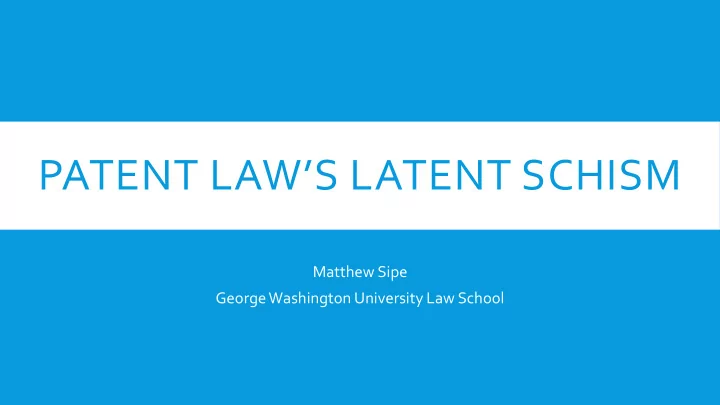

PATENT LAW’S LATENT SCHISM Matthew Sipe George Washington University Law School
UTILITARIAN DOMINANCE VS. MORAL MARGINALIZATION “Patent law is the classic example of an intellectual property regime modeled on the utilitarian framework.” – Menell, Lemley, & Merges Casebook “The economic philosophy behind the clause empowering Congress to grant patents . . . is the conviction that encouragement of individual effort by personal gain is the best way to advance public welfare.” – Mazer v. Stein , 347 U.S. 201, 219 (1954) “The utility of this power will scarcely be questioned. The public good fully coincides . . . With the claims of individuals.” – Federalist No. 43 “Here in America, our creativity has always set us apart, and in order to continue to grow our economy, we need to encourage that spirit.” – President Barack Obama, signing the America Invents Act
UTILITARIAN DOMINANCE VS. MORAL MARGINALIZATION Natural Law & Labor Theory – John Locke Autonomy & Personhood – Immanuel Kant, G.W.F. Hegel Distributive & Social Justice – John Rawls Shared Characteristics: Greater focus on individuals More attention paid to questions of distribution Increased recognition of non-economic values Emphasis on deontology over consequentialism
A NEW PERSPECTIVE: Utilitarian Moral Perspectives Perspectives Validity Infringement Doctrine Doctrine
EXAMINING THE SCHISM
PATENT VALIDITY: THE INFLUENCE OF UTILITARIANISM Novelty Nonobviousness Subject-Matter Eligibility Utility Written Description & Enablement Inventorship
PATENT VALIDITY: THE INFLUENCE OF UTILITARIANISM Nonobviousness An invention must be new to receive patent protection Where the prior art explicitly covers an invention, patentability is rejected under novelty (§ 102) Even if an invention has not been explicitly disclosed in the prior art, it may still be unpatentably “obvious” to a person of ordinary skill in the relevant field For example: trivial modifications or combinations of prior art
PATENT VALIDITY: THE INFLUENCE OF UTILITARIANISM “The patent monopoly was not designed to secure to the inventor his natural right in his discoveries. Rather, it was a reward, an inducement, to bring forth new knowledge. . . . The inherent problem [is] to develop some means of weeding out those inventions which would not be disclosed or devised but for the inducement of a patent .” – Graham v. John Deere Co. , 383 U.S. 1, 8-11 (1966) (emphasis added) Guiding principle: the “inducement standard” of obviousness Practical takeaway: “secondary considerations” (or, “objective indicia”) Commercial success Long-felt, unsolved need Failure of others Skepticism Copying
PATENT VALIDITY: THE INFLUENCE OF UTILITARIANISM Inventorship Patent applications must disclose the name of the actual inventor(s), separate and apart from the assignee/owner Resonance with personhood Must be a natural person or persons Independent of economic interests
PATENT VALIDITY: THE INFLUENCE OF UTILITARIANISM Consistent weakening over time: Pre-1952 – no post-issuance corrections allowed for inventorship 1952-1982 – good-faith and incomplete errors can be corrected 1982-2011 – good-faith errors can be corrected, even if complete 2011-present – all errors can be corrected (for a fee)
PATENT INFRINGEMENT: THE INFLUENCE OF MORALITY Damage Enhancement & Attorney’s Fees Injunctive Relief Doctrine of Equivalents Inequitable Conduct Prior Use
PATENT INFRINGEMENT: THE INFLUENCE OF MORALITY Damage Enhancement & Attorney’s Fees With the 1836 overhaul of the patent statute, enhanced damages go from automatic to discretionary, “according to the circumstances of the case” Broad, discretionary nature is carried through with each new iteration, up to the present Courts consistently describe enhancement as a matter of moral approbation
PATENT INFRINGEMENT: THE INFLUENCE OF MORALITY Damage enhancement requires a guilty mind 2007 – Federal Circuit states that objective recklessness is all that is required for damage enhancement ( In re Seagate , 479 F.3d 1360) 2016 – Supreme Court overrules, holding that subjective intent is the relevant standard Present – Lower courts look for actual prior knowledge of the infringed patent Efficient incentives vs. moral differentiation Undercutting the benefits of disclosure Deviation from other tort regimes
PATENT INFRINGEMENT: THE INFLUENCE OF MORALITY Inequitable Conduct Defense against infringement, based on unclean hands Moral language Harsh remedy Components: (1) Intent to deceive (2) Materiality
PATENT INFRINGEMENT: THE INFLUENCE OF MORALITY (1) Intent to deceive Similar arc as enhanced damages—objective to subjective Pre-2011: “gross negligence,” or “should have known” ( J.P. Stevens & Co., Inc. v. Lex Tex Ltd., Inc. , 747 F.2d 1553 (Fed. Cir. 1984)) 2011-present: “specific intent to deceive the PTO” ( Therasense, Inc. v. Becton, Dickinson and Co. , 649 F.3d 1276, 1290 (Fed. Cir. 2011) (en banc)) (2) Materiality Nominally, “but-for” materiality But a moral backdoor persists
HOW DID WE GET HERE?
CAUSES AND INFLUENCES 1. Dichotomous Adjudication 2. Influence of Property Law 3. Private-Public Law Mixture
CAUSES AND INFLUENCES 1. Dichotomous Adjudication Validity: PTO Fundamentally technocratic Resistant to moralizing Infringement: District Courts and Juries Lack of technical expertise Biases across perceived moral classes of defendants and plaintiffs
CAUSES AND INFLUENCES 2. Influence of Property Law The “thingness” of patent law Distance between rightholder-subject and object-referent Merrill & Smith – the in rem problem Moral trespass, efficient ownership
CAUSES AND INFLUENCES 3. Private-Public Law Mixture Infringement disputes: private law Validity disputes: public law Oil States acknowledges and relies upon the mixture
PRACTICAL IMPLICATIONS
MATTHEW SIPE GEORGE WASHINGTON UNIVERSITY LAW SCHOOL MATTHEW.G.SIPE@GMAIL.COM
Recommend
More recommend